
Chip Wade, builder, interior & furniture designer, media personality and consultant has a unique point of view about the future of furniture design, sales and marketing.
In this Design & Designer installment, Furniture World speaks with Chip Wade, the craftsman, engineer, interior designer, consultant, furniture designer and media presence. He is the founder and CEO of the architecture, design and media firm Wade Works Creative. Armed with a ready smile, a degree in mechanical engineering and a talent for creating multi-functional furniture, he has a unique point of view about the future of interior and furniture design. Chip got his media start in 2007, lending his carpentry skills to the Atlanta team of HGTV’s Designed to Sell. Since then he has been the host, designer and executive producer of the Emmy Award Winning series, Elbow Room, and appeared on HGTV’s Curb Appeal: The Block, Ellen’s Design Challenge, HGTV’s Showdown, HGTV’s Design Star, HGTV’s Wise Buys, Oprah, and CNN.
We asked Chip how his educational background helped inform his work in home furnishings design and marketing.
“There were always lots of projects going on in my family’s house growing up. My dad had a workshop and taught me pretty much how to do everything. I attended Georgia Tech and studied mechanical engineering, which I thought would be a good fit. When I realized my passion was to design and build, I switched to structural engineering. Actually, that’s what I was doing when I got cast on a series for HGTV almost 14 years ago. I was the sidekick character, the demo guy, the closet builder, custom furniture maker, remodeler, electrician, plumber. I basically just did whatever it took to get the job done.
“I built a reputation for being able to make a lot out of a little, which led to hosting my own series called ‘Elbow Room’. I started a design and build firm about nine years ago, and also a production company.”
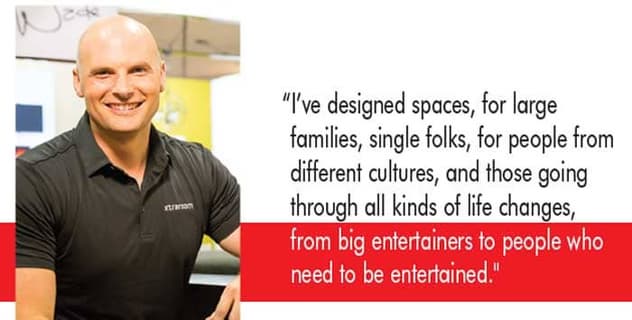
Wade Works Creative
“Today, my company, Wade Works Creative, operates three businesses in architecture and design, real estate and production that all work together. We service mostly lifestyle brands like Kohler, Wolf, Sub-Zero, Mohawk Flooring, and Daltile, doing a lot of interactive content, video, and virtual space creation. We also offer real-client services for residential and commercial customers, both in North America and internationally. Our process is incredibly virtual – very interactive.
“Over the past 15 years, Wade Works Creative has done a lot of space planning. We’ve done over 1500 renovations, new construction, custom home builds, and custom interior design. By working with many hundreds of families, we’ve identified repetitive issues and challenges that families face. Often these issues were solved by designing and building custom pieces, one-off multipurpose furnishings, so they could do more with less. This work led to a new project, a furniture line called “Xtraroom”, which features transitional pieces that help people make the most of their spaces.
“I’ve designed spaces, for large families, single folks, for people from different cultures, and those going through all kinds of life changes, from big entertainers to people who need to be entertained.”
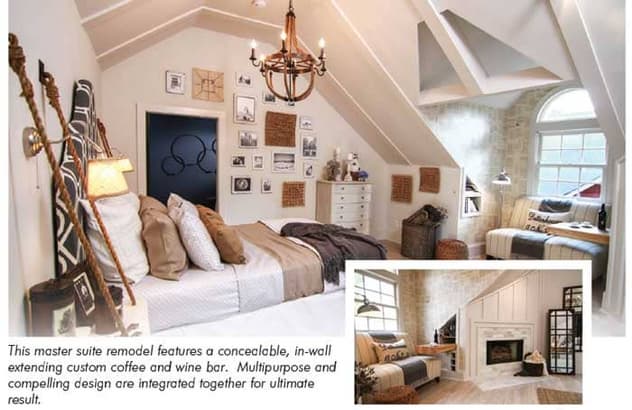
One Piece – Several Uses
You are known for your multipurpose designs – what’s your methodology?
“Each situation presents challenges that need to be addressed. And so, having one item that has multiple functions is one of the exciting things I do. Sometimes no matter which way you position ordinary furniture in a space, it just doesn’t work well. Often that’s the genesis of a successful new idea that combines a number of functions into a multipurpose piece.
“As an engineer, just because I can design something, doesn’t mean I should. It’s not a good philosophy for design in general, and especially not for furniture."
“Great furniture designs don’t look complicated. As an engineer, just because I can design something, doesn’t mean I should. It’s not a good philosophy for design in general, and especially not for furniture. I would describe my designs as a delicate take on multipurpose. There isn’t much bravado or engineering grandeur, just functionality and purposefulness for living.
“I also believe that if it takes more than just a few seconds to be able to transition from one function to another, multi-functional furniture becomes purposeless. It has to be seamless, quick, and of high quality. If it takes two minutes or even 45 seconds to transition a couch into the coolest thing you’ve ever seen, it still isn’t necessarily great. It probably is more expensive to buy and become a problem if it breaks.
“I focus on the quality of the mechanism and the speed in which it can transition from one thing to the other.”
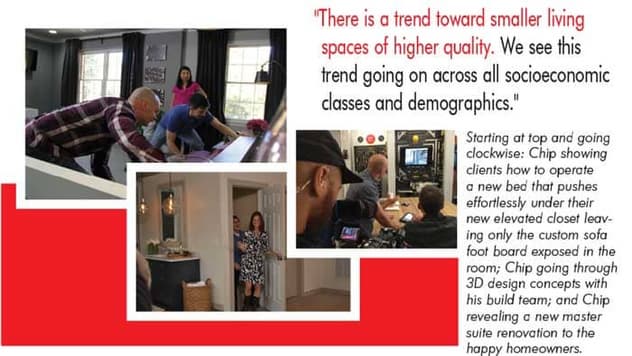
Design Process
Do you have your own preferred design style?
“I never try to intentionally downplay the aesthetic, but I always say, making it look great is the easy part. There are lots of talented people out there who can create great style. Eighty percent of my process has nothing to do with the aesthetic. The final style might be modern, transitional or coastal. We don't really consider the visual style until 70-80 percent of a project has been completed.
“A lot of folks skip over the most important part of designing interior environments, which is personalization. The practical functional layout of spaces should really be driving the show.
“If a customer is just changing one couch out for another, that’s one thing. But many people jump the gun way too quickly when redesigning a living space. They go on a shopping spree before even starting with a functional layout. Doing things in the correct order really makes a difference.”
Creating Design Plans
“For example, when working with a client, I always create a design plan for five to seven years out. When it comes to furnishing homes, a lot of people are stuck in the here and now. They’re designing for next week, or even the next three months. Part of our process includes sending out a crew ahead of time to fully measure a property and build a virtual model in 3D. Then we establish relationships, get to know clients by engaging with them in an initial consultation taking up to three hours.
“Whether in-person or remotely, we can show clients an accurate three-dimensional model of their spaces, plus do live-time analysis and planning. This provides absolute matter-of-fact direction and vetting of all possible options before they actually make a purchase. It gives clients confidence in their purchases and, an exact game plan for execution.”
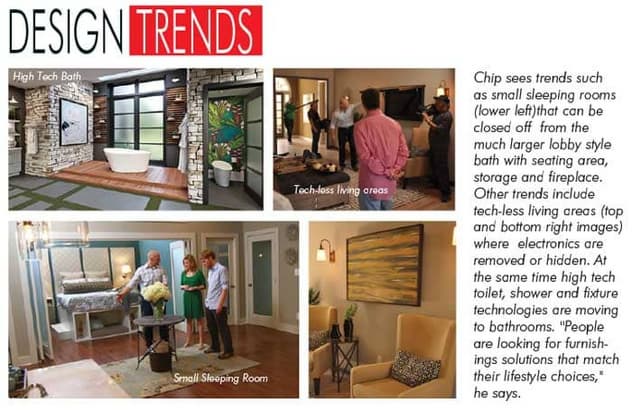
Long-term Planning
Do you think retailers do customers a disservice if they only sell to meet an immediate need without trying to help customers plan longer term?
“Most retailers focus more on presenting individual products than selling full solutions. Of course, not every retail sale or furniture category lends itself to a whole space solution, but many do. It doesn’t help the consumer to visualize the whole solution when they are just shopping for a lamp or a light fixture. Many people, however, are in an insecure place when shopping for their homes and benefit from retailers who’ve taken the time to create a more curated environment.
“Just giving consumers a sense of how a room will look and feel, so they can visualize how different pieces go together, and how function can ultimately change lifestyle, is something that I think is largely missing from today’s retail environments. Furniture retailers are largely product focused rather than solution focused. At Wade Works Creative we tell the story of space solutions, curate and credentialize selections together to give people confidence that their purchasing choices will work and will also look great together.”
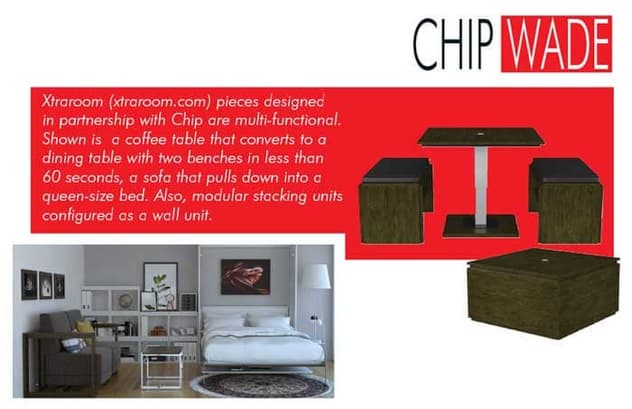
Changing Tastes
Are you seeing major changes in housing and furnishings?
“2017 was the first year in the last 15, where the average square footage of new construction homes has gone down, which is a really big deal. There is a trend toward smaller living spaces of higher quality. We see this trend going on across all socioeconomic classes and demographics.
“Another trend I’m really excited about is a focus on creating utility for individual rooms. The standard model of 80s and 90s suburban homes – a foyer, office to the left, dining room to the right, kitchen in the back and living room – is transitioning to very specific-use rooms. These rooms are being updated to mirror trends in living. People are looking for furnishings solutions that match their lifestyle choices.
“We are seeing ‘tech-less’ living rooms, where technology is removed so that family and friends can gather and interact. Bathrooms, however, are going in the opposite direction by incorporating tech solutions in toilet technology, vanities, voice-activated technologies, plumbing fixtures, showers, calendar heads-up displays, all integrated. The bathroom is turning into one of the tech hubs of the home.
“A slower moving trend, but one that will pick up steam, is that of small bedrooms – more affectionately called sleeping rooms. Bedrooms are getting smaller and bathrooms are getting larger. The master suite, the big open concept bedroom, is one that people are finally realizing doesn’t make a whole lot of sense. When you walk into a massive room with a bed, a big fireplace, huge floor-to-ceiling windows and cathedral ceilings, while it makes for a pretty picture, it’s incredibly impractical. Today, people are catching on. They want to use square footage for something more practical that includes only what’s really necessary.
“People are allocating additional square footage and specifying more integrated solutions to spaces where they are actually awake, moving around, and interacting.”
Economy of Scale
Are economic forces driving any of these changes?
“Fewer people want to live in homes with massive square footage. With the cost of living going up, money buys a little bit less square footage. People don’t necessarily want massive homes that need to be fixed and maintained. The design challenge for our industry, as far as space goes, is to make space work for people. I have spent the last 12 years of my life focusing on how to make the most of space to improve people’s lives.
“Many of the big names are spending lots of time creating strategic, cooperative partnerships inside and outside of the furnishings world. This is going to be interesting to watch. For example, brands that make upholstered furniture, will collaborate with paint and flooring manufacturers as well as art and décor brands, to create full-spectrum solutions along with visualization platforms that cover the entire range with fully shoppable rooms.
The End of the Trend?
You have said that you’re not for or against trends. What did you mean?
“There are two different categories of trends. There are ones that cycle in and out without going completely out of style. Like white, for example. Has white ever gone out completely? No, it gets hot and then it cools off a little bit. It’s a staple, consistent across multiple generations.
“And then there are more volatile trends created by brands and retailers to focus attention so consumers can embrace an entire new design aesthetic. Products are coordinated by look and feel and come to define what we call a ‘trend.’
“My feeling is that as visualization technologies become better and easier to use, trends themselves are going to be less prominent. They won’t be as necessary a selling tool. We’re not going to need a color of the year. We’re not going to need to know that shiplap is a trend.
“Visualization is becoming configurable, more personalized. Design professionals will be able to create more individualized curated looks that are more specific to people’s real aesthetic and functional needs.
The power of a trend as a mechanism to consolidate confidence in consumer purchasing habits is going to go down as visualization technology and capability for personalization goes up. Consumer needs will drive marketing and purchasing to a greater degree.
“I take a personalized approach to designing spaces. It’s not about whatever’s popular for the moment. I tend towards creating spaces that are a bit more timeless, and use more aggressive styling that’s scalable, approachable and responsible, to make things feel more relevant in the moment.”
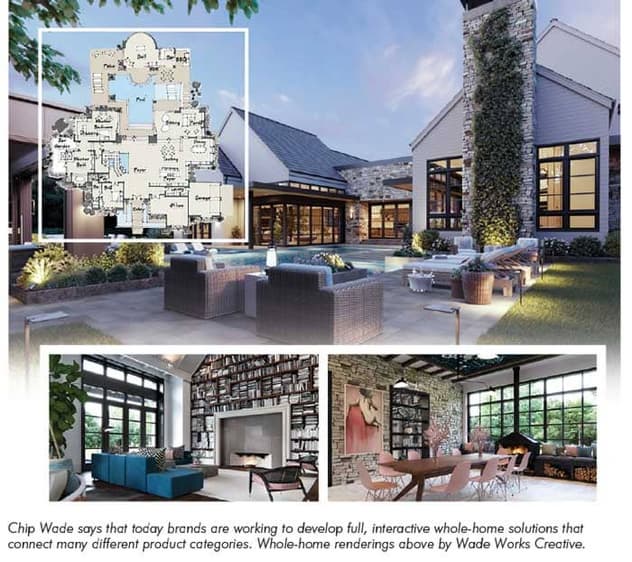
Retail Relevance
How might retailers start to do what you do, both online and in their stores?
“In our industry, retail experiences are generally stuck in 1990. Even though kiosks have been updated, I see showrooms full of random products with flashy graphics. The retailer of the future will need to intertwine the digital interactive point-of-purchase platform with the bricks-and-mortar experience so they are synonymous. Retailers are going to be forced to use their square footage in a much different way.
“They are going to have to elevate both user experiences and the immersive nature of sales presentations so that consumers can visualize products in their own homes with physical touch and feel. Showing 500 different products in a brick-and-mortar location is not as powerful as allowing customers to interact with products and visualize how they will be used in their own spaces.
“Brands are working to develop these types of solutions – not just in furnishings, but also for plumbing, tile and flooring, rugs, and lighting fixtures – with full, interactive whole-home solutions that connect many different product categories.
“Retailers will need to ask themselves, ‘What solutions are we providing to homeowners?’ If the only solution they are providing is a picture of a product with specifications and basement-bottom pricing, they are going to lose out as competition for better shopping experiences continues to get more intense.”
Retailers and Interactivity
How might retailers begin moving into more interactive arenas?
“My suggestion is that retailers should not necessarily be so concerned right now with augmented reality-type solutions that allow consumers to take a picture of their living room and then place products. This is definitely a ‘thing’, and it’s a solution, but right now the rendering quality for these types of instantaneous solutions is not quite there yet – although it will be in the very near future.
“Better to start with the first foundational-level building block of planning for versatility in an interactive world. That means to virtualize product lines instead of relying only on physical photography or physical product samples. I believe that creating full photo-realistic, ultra-high resolution, virtual 3D environment models will position furniture companies to take advantage of all very high-yield future interactive platforms including websites, animation and video.
“Bottom line, the idea is to create a library of products, SKUs, colors and finishes for brands to put consumers in the driver’s seat, allowing them to do anything they want. There are a lot of companies that offer services in the virtual realm. Retailers should not cripple themselves by making an economic choice when it comes to modeling; it is essential to get the right resolution along with the right criteria suitable across multiple platforms.
“Interestingly enough, the smaller the retailer, the smaller the number of SKUs they are focused on, the easier this technology is to adopt. Retailers with fewer SKUs and curated product selections can more affordably create an entire virtual portfolio.
"Showing 500 different products in a brick-and-mortar location is not as powerful as allowing customers to interact with products and visualize how they will be used in their own spaces."
“Not every single sku has to become virtual immediately. Generally, 60 - 80 percent of profits come from 20 - 25 percent of the products carried. So, a retailer’s most high-yield inventory can be virtualized in a very short period. Over time, new incoming inventory can be added as an ongoing strategy.”
Remember the Story
“In retail, telling the right story to consumers is extremely important. Sometimes, having a couch that has a desk that changes into a bed is great, but when somebody comes into a retail store, they have thought about their requirements. If a piece of furniture doesn’t seem relevant to those needs, the sale won’t be made. Retailers, therefore, need to craft stories about multi-functional furniture with a full-spectrum arc that allows consumers to resonate with the solution. This is a new type of marketing and a new type of storytelling for furniture retailers.
“Finally, retailers should be on the lookout for big changes in the way furnishings will be sold. Changes include exciting new products, technologies and interactive solutions, that help brands and retailers tell stories relevant to their customers’ lifestyle aspirations, while greatly improving the shopping experience.”
Furniture World is the oldest, continuously published trade publication in the United States. It is published for the benefit of furniture retail executives. Print circulation of 20,000 is directed primarily to furniture retailers in the US and Canada. In 1970, the magazine established and endowed the Bernice Bienenstock Furniture Library (www.furniturelibrary.com) in High Point, NC, now a public foundation containing more than 5,000 books on furniture and design dating from 1620. For more information contact editor@furninfo.com.